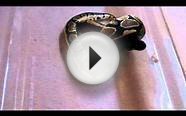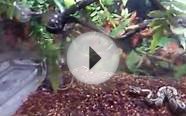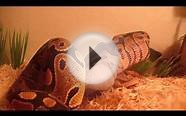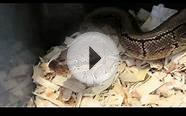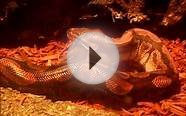Small Ball Python
 Keeping ball pythons as pets is easier than most people think. Ball pythons make a good choice for first time snake owners because they are a relatively small and docile species of snake. Having one of these snakes can be a very rewarding experience.
Keeping ball pythons as pets is easier than most people think. Ball pythons make a good choice for first time snake owners because they are a relatively small and docile species of snake. Having one of these snakes can be a very rewarding experience.
Ball Pythons
Ball pythons, also known as royal pythons or pythons regius, are in the same snake family as boas. All of these snakes are constrictors. Constrictor snakes wrap their body around their prey until the creature suffocates, and then they swallow it whole. Ball pythons are fairly small, and the typically reach only 36 to 48 inches long in adulthood. Pet stores that specialize in snakes will either have ball pythons on hand to purchase, or they may help you find a breeder.
Benefits of Ball Pythons as Pets
Many people enjoy owning a ball python as their first pet snake because it is easy to handle. The more you handle and hold your ball python, the tamer it will become as it grows used to your touch. It is a good idea to bring your snake out once per day to interact. Other benefits of ball pythons as pets are:
- They require very little maintenance as compared to caring for a dog or cat.
- They eat only once per week.
- They only defecate approximately once per week.
- Cage cleanup is fairly easy.
- Ball pythons can live up to 50 years when cared for in captivity, but on average they live 20 to 30 years.
Setting up the Cage
A 30-gallon glass aquarium makes a decent habitat for a snake. Make sure it has a secure lid with ventilation. Pet stores make screen lids specifically for reptile aquariums. Cover the bottom of the cage with a substrate such as newspaper, astro turf for reptiles, orchid bark or moss. Some people like to use aspen or pine shavings for substrate, but these can both make the environment a bit too dry for your pet's comfort.
Supply the cage with:
- A water bowl
- A soaking tub
- A heat lamp with timer
- A thermometer
- A light
- A box to hide in
- An object to rub up against to remove skin
Feeding
Ball pythons eat either mice or small rats. Usually these meals are live, but sometimes you can train your ball python to eat a frozen (thawed out) mouse. Whatever you decide to feed your snake when it is young is what it will continue to want to eat when it is older. If you prefer to feed your snake live rodents, start him out on that while he is young. Otherwise, choose thawed out, frozen mice. Pet supply stores usually stock both types of rodents for snakes to eat.
The feeding process:
- Place the rodent in the cage or in another container you have chosen to use for feeding.
- Place the snake in the same cage.
- Place the lid back on the cage and wait until the snake senses his meal has been served.
- Stay and observe the eating process; if the snake is not hungry, the mouse or snake should be removed because it can scratch or bite the snake.
- If the snake did not eat, try feeding him the next day.
You might also like
